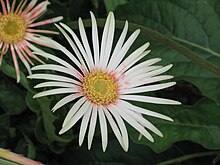| Gerbera jamesonii | |
|---|---|

| |
| Gerbera jamesonii from Mpumalanga | |
| Scientific classification | |
| Kingdom: | Plantae |
| Clade: | Tracheophytes |
| Clade: | Angiosperms |
| Clade: | Eudicots |
| Clade: | Asterids |
| Order: | Asterales |
| Family: | Asteraceae |
| Genus: | Gerbera |
| Species: | G. jamesonii |
| Binomial name | |
| Gerbera jamesonii Bolus ex Hooker f. (1889) | |
Gerbera jamesonii is a species of flowering plant in the genus Gerbera belonging to the basal Mutisieae tribe within the large Asteraceae (or Compositae) family. It is indigenous to South Eastern Africa and commonly known as the Barberton daisy, the Transvaal daisy, and as Barbertonse madeliefie or Rooigousblom in Afrikaans. It was the first species of Gerbera to be the subject of a scientific description, studied by J. D. Hooker in Curtis's Botanical Magazine in 1889.
Etymology
The genus was named in honour of German botanist and medical doctor Traugott Gerber (1710 — 1743).
The Gerbera jamesonii was named in honour of Robert Jameson, who collected the plant near Barberton. The species epithet was proposed by the prominent South African botanist Harry Bolus, but first published by Richard Wills Adlam in 1888, so should be ascribed to him.
Description


Gerbera jamesonii is a tufted perennial herb with the naked flowering scapes up to 75 cm high. Petiolate, deeply undulating or lobed leaves are 15–42 (up to 68) cm long and 4–14 cm wide, gathered in rosette. The plant produces spectacular flowers (capitula) of 4–5 cm in diameter with normally orange-red (rarely yellow, orange, white, pink) ray florets. It flowers from September to December, reproduces asexually. The seeds have a pappus of bristles.
Distribution
Gerbera jamesonii is endemic to Mpumalanga, Limpopo and Eswatini. The plant is introduced into several countries of Latin America, Equatorial Africa and Southeast Asia.
Ecology
The species grows from 500 to 1670 m above sea level on rocky slopes in woodland, usually in some shade or under bushes and trees. The flowers are pollinated by bees and other insects. The seeds are light and easily dispersed by wind.
Uses
The species is the ancestor of all cultivated forms of Gerbera, or they originate from the cross Gerbera jamesonii and Gerbera viridifolia, originally made by R. I. Lynch in Cambridge, England about 1890. He named the hybrid as Gerbera × cantebrigiensis, known today as Gerbera × hybrida. Nowadays thousands of cultivars exist and they are the important article of trade belonging to the most important ornamental crops in the world together with rose, chrysanthemum, carnation, lily and tulip. The popular cultivars include "Sazou", "Sangria", "Rosalin", "Pink Elegance", "Tropic Blend", "Piton", "Winter Queen", "Savannah", "Primrose" and many others. They are propagated by tissue culture and by seeds.
In culture
The flag and coat of arms of the Province of Mpumalanga include a depiction of this flower.
Pests
Fungi
- Foot rot caused by Phytophthora tentaculata
- Root rot caused by Rhizoctonia solani and Pythium irregulare.
- Grey mildew caused by Botrytis cinerea
- White powdery mildew caused by Golovinomyces cichoracearum
- Leaf blight caused by Alternaria alternata, A. citri, A. tennuisssima.
- Leaf spots caused by Ascochyta gerberae, Gloeosporium spp. and other fungi.
Insects
- Plant lice Aphids.
- Leafminer Liriomyza trifolii.
- Greenhouse whiteflies Trialeurodes vaporariorum and Bemisia tabaci.
- Thrips Thrips tabaci and Heliothrips haemorrhoidalis.
Mites
- Spider mite Tetranychus urticae
- Broad mite Polyphagotarsonemus latus.
- Cyclamen mite Steneotarsonemus pallidus.
References
- "Gerbera jamesonii". Integrated Taxonomic Information System. Retrieved October 7, 2007.
- Siyabona Africa http://www.krugerpark.co.za/africa_barberton_daisy.html
- "Traugott Gerber". Gerbera.org.
- Manning, John (March 29, 2019). Field guide to wild flowers of South Africa, Lesotho and Swaziland. Cape Town: Struik Nature. p. 406. ISBN 9781770077584.
- "Gerbera jamesonii Bolus". Plants of the World Online. Kew Science.
- "Barberton Daisy". Gerbera.org. Retrieved 4 February 2022.
- "Gerbera jamesonii". pza.sanbi.org. PlantZAfrica. Retrieved 4 February 2022.
- "Lynch, Richard Irwin (1850–1924), horticulturist and botanist". Oxford Dictionary of National Biography (online ed.). Oxford University Press. 2004. doi:10.1093/ref:odnb/96825. (Subscription or UK public library membership required.)
- "Mpumalanga Province, South Africa". www.fotw.info.
- Cristinzio, G.; Camele, I.; Marcone, C. (2006). "First report of Phytophthora tentaculata on gerbera in Italy [Campania]". Informatore Fitopatologico (Italy) (in Italian). Archived from the original on 2022-02-04. Retrieved 2022-02-04.
- Krober, H.; Plate, H. (1975). "Pythium species as well as Rhizoctonia solani as pathogens of Gerbera". Biology: 150–152. S2CID 82432367.
- van Kan, J. A. L.; van 't Klooster, J. W.; Wagemakers, C. A. M.; Dees, D. C. T.; van der Vlugt-Bergmans, C. J. B. (January 1997). "Cutinase A of Botrytis cinerea is Expressed, but not Essential, During Penetration of Gerbera and Tomato". Molecular Plant-Microbe Interactions. 10 (1): 30–38. doi:10.1094/MPMI.1997.10.1.30. PMID 9002270.
- "Gerbera Daisy-Powdery Mildew". Pacific Northwest Pest Management Handbooks. 11 September 2015.
- Bhat, Hilal Ahmad; Ahmad, Khurshid; Ahanger, Rayees A. (18 March 2013). "Status and symptomatology of Alternaria leaf blight (Alternaria alternata) of Gerbera (Gerbera jamisonii) in Kashmir valley". African Journal of Agricultural Research. 8 (9): 819–823.
- Krips, O. E.; Willems, P. E. L.; Gols, R.; Posthumus, M. A.; Dicke, M. (1999). "The Response of Phytoseiulus persimilis to Spider Mite-Induced Volatiles from Gerbera: Influence of Starvation and Experience". Journal of Chemical Ecology. 25 (12): 2623–2641. doi:10.1023/A:1020887104771. S2CID 34957958.
- Smith, Floyd F. (1939). "Control of cyclamen and broad mites on Gerbera". U.S. Dept. of Agriculture. doi:10.5962/bhl.title.64321. hdl:2027/uiug.30112019272506.
{{cite journal}}: Cite journal requires|journal=(help)
External links
 Media related to Gerbera jamesonii at Wikimedia Commons
Media related to Gerbera jamesonii at Wikimedia Commons Data related to Gerbera jamesonii at Wikispecies
Data related to Gerbera jamesonii at Wikispecies- Gerbera.org - Official website of the Gerbera Association - established in Barberton.
| Taxon identifiers | |
|---|---|
| Gerbera jamesonii |
|




